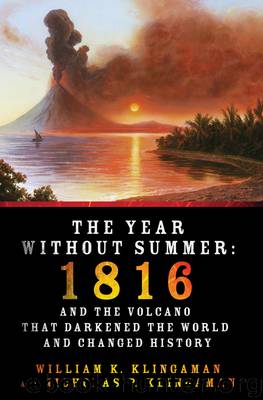The Year Without Summer: 1816 and the Volcano That Darkened the World and Changed History by William K. Klingaman & Nicholas P. Klingaman

Author:William K. Klingaman & Nicholas P. Klingaman [Klingaman, William K. & Klingaman, Nicholas P.]
Language: eng
Format: epub, mobi
ISBN: 9780312676452
Amazon: 031267645X
Publisher: St. Martin's Press
Published: 2013-02-26T05:00:00+00:00
8.
THE PRICE OF BREAD
“There has not been this whole summer one day of steady sunshine, not one day of heat, nor one night when a coverlet and blanket could have been thrown off with comfort…”
GHENT, AUGUST 3: “The waters are excessively high, and have not subsided for these three days. The Scheldt is at the height of 16 feet at Oudenarde. Our rich and beautiful meadows are partly inundated. The grass which is not mown will rot in the water, and that which was already mown has been carried off by the current. Hay has risen 100 per cent.” Outside of Antwerp, a severe hailstorm ruined crops waiting to be harvested.
In Württemberg in southwestern Germany, the sun seldom shone for more than a small part of the day. “Thunderstorms brought forth the worst weather, so that one could say a quarter or even a third of the grain was ruined throughout the state,” wrote the mayor of Geradstetten. “The weather also caused the potatoes to rot in the ground, and in many towns you could not harvest as many potatoes as you planted. Similarly it went in the vineyards, where the grapes did not ripen. The same fate befell the high hills as well as the high meadow.” From all parts of Denmark came complaints of constant storms; in Copenhagen it rained nearly every day for five weeks.
Reports of devastating storms and floods throughout France poured into London in the first week of August. “The weather continues as ungenial in that country as with us,” noted The Times. In Burgundy, rain and cold “have ruined the finer sort of vines,” and threatened to wipe out the common ones as well. At Chambray, just south of Geneva, snow fell on the mountains outside of town. Residents of Grenoble, in southeastern France, were trapped between two flooding rivers. The Isère overflowed its banks, sending water cascading through the entire valley. Meanwhile the Drec “burst its dikes … and in consequence three or four villages, together with the suburbs of Grenoble, were inundated.”
On August 5, storms struck the department of Haute-Marne to the north. “The increase of waters has every where been greater than was ever before known,” reported one correspondent, “and what yet remained in the meadows has been swept away and destroyed. Independent of the loss of hay, more than 15 communes have had their crops completely destroyed.” The same storm struck Nancy, where “the harvest is completely destroyed: wheat, barley, oats, vegetables, vines, and even trees…”
In Paris, the Seine continued to rise. On August 4, church authorities ordered additional prayers for nine days in all the city’s churches for better weather; the following day, the churches were filled “with an immense concourse of the faithful.” For a moment, it seemed as if their prayers were answered. By August 9, the rain ceased and warm temperatures returned. An unofficial survey of the state of French crops concluded that “the first crop of hay has been almost universally destroyed or spoiled; and
Download
The Year Without Summer: 1816 and the Volcano That Darkened the World and Changed History by William K. Klingaman & Nicholas P. Klingaman.mobi
This site does not store any files on its server. We only index and link to content provided by other sites. Please contact the content providers to delete copyright contents if any and email us, we'll remove relevant links or contents immediately.
Man-made Catastrophes and Risk Information Concealment by Dmitry Chernov & Didier Sornette(5921)
The Revenge of Geography: What the Map Tells Us About Coming Conflicts and the Battle Against Fate by Kaplan Robert D(4035)
Zero Waste Home by Bea Johnson(3777)
COSMOS by Carl Sagan(3554)
Good by S. Walden(3487)
In a Sunburned Country by Bill Bryson(3483)
The Fate of Rome: Climate, Disease, and the End of an Empire (The Princeton History of the Ancient World) by Kyle Harper(3003)
A Wilder Time by William E. Glassley(2818)
Camino Island by John Grisham(2762)
The Ogre by Doug Scott(2631)
Organic Mushroom Farming and Mycoremediation by Tradd Cotter(2626)
Human Dynamics Research in Smart and Connected Communities by Shih-Lung Shaw & Daniel Sui(2466)
Energy Myths and Realities by Vaclav Smil(2438)
The Traveler's Gift by Andy Andrews(2409)
9781803241661-PYTHON FOR ARCGIS PRO by Unknown(2323)
Inside the Middle East by Avi Melamed(2305)
Birds of New Guinea by Pratt Thane K.; Beehler Bruce M.; Anderton John C(2224)
A History of Warfare by John Keegan(2186)
And the Band Played On by Randy Shilts(2129)
